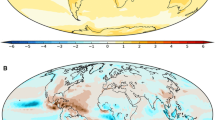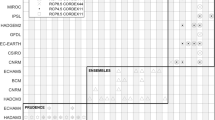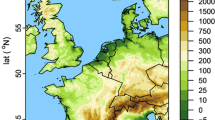Abstract
Climate modelers often integrate the model with constant forcing over a long time period, and make an average over the period in order to reduce climate noise. If the time series is persistent, as opposed to rapidly varying, such an average does not reduce noise efficiently. In this case, ensemble runs, which ideally represent independent runs, can reduce noise more efficiently. We quantify the noise reduction gain by using ensemble runs over a long continuous run in constant‐forcing simulations. We find that in terms of the amplitude of the noise, a continuous simulation of 30 years may be equivalent to as few as five 3-year long ensemble runs in a slab ocean–atmosphere coupled model and as few as two 3-year long ensemble runs in a fully coupled model. The outperformance of ensemble runs over a continuous run is strictly a function of the persistence of the time series. We find that persistence depends on model, location and variable, and that persistence in surface air temperature has robust spatial structures in coupled models. We demonstrate that lag-1 year autocorrelation represents persistence fairly well, but the use of lag-1 year–lag-5 years autocorrelations represents the persistence far more sufficiently. Furthermore, there is more persistence in coupled model output than in the output of a first-order autoregressive model with the same lag-1 autocorrelation.









Similar content being viewed by others
References
Allen RJ, Sherwood SC (2011) The impact of natural versus anthropogenic aerosols on atmospheric circulation in the community atmosphere model. Clim Dyn 36(9–10):1959–1978
Bryan K (1984) Accelerating the convergence to equilibrium of ocean-climate models. J Phys Oceanogr 14(4):666–673
Bryan FO (1998) Climate drift in a multicentury integration of the NCAR climate system model. J Clim 11(6):1455–1471
Cagnazzo C, Manzini E, Giorgetta MA, Forster PMDF, Morcrette JJ (2007) Impact of an improved shortwave radiation scheme in the MAECHAM5 general circulation model. Atmos Chem Phys 7(10):2503–2515. doi:10.5194/acp-7-2503-2007
Carré M, Sachs JP, Wallace JM, Favier C (2012) Exploring errors in paleoclimate proxy reconstructions using Monte Carlo simulations: paleotemperature from mollusk and coral geochemistry. Clim Past 8(2):433–450. doi:10.5194/cp-8-433-2012
Chung CE, Ramanathan V (2006) Weakening of north Indian SST gradients and the monsoon rainfall in India and the Sahel. J Clim 19(10):2036–2045. doi:10.1175/JCLI3820.1
Chung CE, Ramanathan V, Kiehl JT (2002) Effects of the South Asian absorbing haze on the northeast monsoon and surface–air heat exchange. J Clim 15(17):2462–2476. doi:10.1175/1520-0442(2002)015<2462:EOTSAA>2.0.CO;2
Cubasch U, Meehl GA, Boer GJ, Stouffer RJ, Dix M, Noda A, Senior CA, Raper S, Yap KS (2001) Projections of future climate change. In: Houghton JT, Ding Y, Griggs DJ, Noguer M, van der Linden PJ, Dai X, Maskell K, Johnson CA (eds) Climate change 2001: the scientific basis. Contribution of Working Group I to the third assessment report of the Intergovernmental Panel on Climate Change. Cambridge University Press, Cambridge, p 881
Dai A, Meehl GA, Washington WM, Wigley TML, Arblaster JM (2001) Ensemble simulation of twenty-first century climate changes: business-as-usual versus CO2 stabilization. Bull Am Meteorol Soc 82(11):2377–2388. doi:10.1175/1520-0477(2001)082<2377:ESOTFC>2.3.CO;2
Dakos V, Scheffer M, van Nes EH, Brovkin V, Petoukhov V, Held H (2008) Slowing down as an early warning signal for abrupt climate change. Proc Natl Acad Sci 105(38):14308–14312
Danabasoglu G, Gent PR (2009) Equilibrium climate sensitivity: is it accurate to use a slab ocean model? J Clim 22(9):2494–2499. doi:10.1175/2008JCLI2596.1
Delworth TL, Knutson TR (2000) Simulation of early 20th century global warming. Science 287(5461):2246–2250. doi:10.1126/science.287.5461.2246
Deser C, Phillips A, Bourdette V, Teng H (2012) Uncertainty in climate change projections: the role of internal variability. Clim Dyn 38(3–4):527–546
Haughton N (2012) Climate model ensemble generation and model dependence. Dissertation, University of New South Wales, New South Wales
Kalnay E, Yang SC (2010) Accelerating the spin-up of ensemble Kalman filtering. Q J R Meteorol Soc 136(651):1644–1651
Kiehl JT, Shields CA, Hack JJ, Collins WD (2006) The climate sensitivity of the community climate system model version 3 (CCSM3). J Clim 19(11):2584–2596
Kug J-S, Ham Y-G, Kimoto M, Jin F-F, Kang I-S (2010) New approach for optimal perturbation method in ensemble climate prediction with empirical singular vector. Clim Dyn 35(2–3):331–340
Künsch HR (1989) The jackknife and the bootstrap for general stationary observations. Ann Stat 17(3):25
Leith CE (1973) The standard error of time-average estimates of climatic means. J Appl Meteorol 12(6):1066–1069. doi:10.1175/1520-0450(1973)012<1066:TSEOTA>2.0.CO;2
Liu Z, Lewis W, Ganopolski A (2004) An acceleration scheme for the simulation of long term climate evolution. Clim Dyn 22(6–7):771–781. doi:10.1007/s00382-004-0416-y
Min S-K, Legutke S, Hense A, Kwon W-T (2005) Internal variability in a 1000-yr control simulation with the coupled climate model ECHO-G—II. El Niño southern oscillation and North Atlantic oscillation. Tellus 57A:622–640
Räisänen P, Järvinen H (2010) Impact of cloud and radiation scheme modifications on climate simulated by the ECHAM5 atmospheric GCM. Q J R Meteorol Soc 136(652):1733–1752
Räisänen P, Järvenoja S, Järvinen H (2008) Noise due to the Monte Carlo independent-column approximation: short-term and long-term impacts in ECHAM5. Q J R Meteorol Soc 134(631):481–495
Randall DA, Wood RA, Bony S, Colman R, Fichefet T, Fyfe J, Kattsov V, Pitman A, Shukla J, Srinivasan J, Stouffer RJ, Sumi A, Taylor KE (2007) Cilmate models and their evaluation. In: Kim J-W, Stone J, Solomon S, Qin D, Manning M, Chen Z, Marquis M, Averyt KB, Tignor M, Miller HL (eds) Climate change 2007: the physical science basis. Contribution of Working Group I to the fourth assessment report of the Intergovernmental Panel on Climate Change. Cambridge University Press, Cambridge
Roeckner E, Arpe K, Bengtsson L, Christoph M, Claussen M, Dümenil L, Esch M, Giorgetta, M, Schlese U, Schulzweida U (1996) The atmospheric general circulation model ECHAM-4: model description and simulation of present-day climate. MPI-Report 218, Max-Planck Institute for Meteorology, Hamburg
Roeckner E, Bäuml G, Bonaventura L, Brokopf R, Esch M, Giorgetta M, Hagemann S, Kornblueh L, Schlese U, Schulzweida U, Kirchner I, Manzini E, Rhodin A, Tompkins A (2003) The atmospheric general circulation model ECHAM 5. Part I: model description. MPI-Report 349, Max-Planck-Institut für Meteorologie, Hamburg
Roeckner E, Brokopf R, Esch M, Giorgetta M, Hagemann S, Kornblueh L, Manzini E, Schlese U, Schulzweida U (2006) Sensitivity of simulated climate to horizontal and vertical resolution in the ECHAM5 atmosphere model. J Clim 19(16):3771–3791. doi:10.1175/JCLI3824.1
Taylor KE, Williamson D, Zwiers F (2000) The sea surface temperature and sea-ice concentration boundary conditions for AMIP II simulations, PCMDI Report No. 60, program for climate model diagnosis and intercomparison. Lawrence Livermore National Laboratory, Livermore, 25 pp
Toth Z, Kalnay E (1997) Ensemble forecasting at NCEP and the breeding method. Mon Weather Rev 125(12):3297–3319
Trenberth KE (1984) Some effects of finite sample size and persistence on meteorological statistics. Part I: autocorrelations. Mon Weather Rev 112(12):2359–2368
Washington WM, Weatherly JW, Meehl GA, Semtner AJ Jr, Bettge TW, Craig AP, Strand WG Jr, Arblaster J, Wayland VB, James R, Zhang Y (2000) Parallel climate model (PCM) control and transient simulations. Clim Dyn 16(10–11):755–774. doi:10.1007/s003820000079
Wilks DS (1997) Resampling hypothesis tests for autocorrelated fields. J Clim 10(1):65–82. doi:10.1175/1520-0442(1997)010<0065:rhtfaf>2.0.co;2
Wilks DS (2011) Statistical methods in the atmospheric sciences. International geophysics series, vol 100, 3rd edn. Academic Press, New York
Yoshimori M, Stocker TF, Raible CC, Renold M (2005) Externally forced and internal variability in ensemble climate simulations of the Maunder Minimum. J Clim 18(20):4253–4270. doi:10.1175/JCLI3537.1
Zorita E, González-Rouco F, Legutke S (2003) Testing the Mannetal. (1998) approach to paleoclimate reconstructions in the context of a 1000-yr control simulation with the ECHO-G coupled climate model. J Clim 16(9):1378–1390. doi:10.1175/1520-0442(2003)16<1378:ttmeaa>2.0.co;2
Zwiers FW, Von Storch H (1995) Taking serial correlation into account in tests of the mean. J Clim 8(2):336–351. doi:10.1175/1520-0442(1995)008<0336:tsciai>2.0.co;2
Acknowledgments
We acknowledge the Model and Data Group at the Max Planck Institut für Meteorologie for making their ECHO-G output available for analysis. Special thanks go to Eduardo Zorita of the Helmholtz-Zentrum Geesthacht for pointing us to this data. This research was supported by the Korea Meteorological Administration Research and Development Program (CATER 2012-7100).
Author information
Authors and Affiliations
Corresponding author
Rights and permissions
About this article
Cite this article
Decremer, D., Chung, C.E. & Räisänen, P. Strategies for reducing the climate noise in model simulations: ensemble runs versus a long continuous run. Clim Dyn 44, 1367–1379 (2015). https://doi.org/10.1007/s00382-014-2161-1
Received:
Accepted:
Published:
Issue Date:
DOI: https://doi.org/10.1007/s00382-014-2161-1




